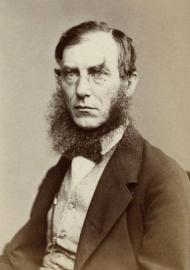Einstein's "Zur Elektrodynamik bewegter Körper" ("On the Electrodynamics of Moving Bodies"), his third paper that year, was received on June 30 and published September 26. It reconciles Maxwell's equations for electricity and magnetism with the laws of mechanics by introducing major changes to mechanics close to the speed of light. This later became known as Einstein's special theory of relativity.
The paper mentions the names of only five other scientists, Isaac Newton, James Clerk Maxwell, Heinrich Hertz, Christian Doppler, and Hendrik Lorentz. It does not have any references to any other publications. Many of the ideas had already been published by others, as detailed in history of special relativity and relativity priority dispute. However, Einstein's paper introduces a theory of time, distance, mass, and energy that was consistent with electromagnetism, but omitted the force of gravity.
At the time, it was known that Maxwell's equations, when applied to moving bodies, led to asymmetries (Moving magnet and conductor problem), and that it had not been possible to discover any motion of the Earth relative to the 'light medium'. Einstein puts forward two postulates to explain these observations. First, he applies the principle of relativity, which states that the laws of physics remain the same for any non-accelerating frame of reference (called an inertial reference frame), to the laws of electrodynamics and optics as well as mechanics. In the second postulate, Einstein proposes that the speed of light has the same value in all inertial frames of reference, independent of the state of motion of the emitting body.
Special relativity is thus consistent with the result of the Michelson–Morley experiment, which had not detected a medium of conductance (or aether) for light waves unlike other known waves that require a medium (such as water or air). Einstein may not have known about that experiment, but states,
Examples of this sort, together with the unsuccessful attempts to discover any motion of the earth relatively to the "light medium," suggest that the phenomena of electrodynamics as well as of mechanics possess no properties corresponding to the idea of absolute rest.
The speed of light is fixed, and thus not relative to the movement of the observer. This was impossible under Newtonian classical mechanics. Einstein argues,
… the same laws of electrodynamics and optics will be valid for all frames of reference for which the equations of mechanics hold good. We will raise this conjecture (the purport of which will hereafter be called the "Principle of Relativity") to the status of a postulate, and also introduce another postulate, which is only apparently irreconcilable with the former, namely, that light is always propagated in empty space with a definite velocity
c which is independent of the state of motion of the emitting body. These two postulates suffice for the attainment of a simple and consistent theory of the electrodynamics of moving bodies based on Maxwell's theory for stationary bodies. The introduction of a "luminiferous ether" will prove to be superfluous in as much as the view here to be developed will not require an "absolutely stationary space" provided with special properties, nor assign a velocity-vector to a point of the empty space in which electromagnetic processes take place.The theory
[…] is based—like all electrodynamics—on the kinematics of the rigid body, since the assertions of any such theory have to do with the relationships between rigid bodies (systems of co-ordinates), clocks, and electromagnetic processes. Insufficient consideration of this circumstance lies at the root of the difficulties which the electrodynamics of moving bodies at present encounters.
It had previously been proposed, by George FitzGerald in 1889 and by Lorentz in 1892, independently of each other, that the Michelson-Morley result could be accounted for if moving bodies were contracted in the direction of their motion. Some of the paper's core equations, the Lorentz transforms, had been published by Joseph Larmor (1897, 1900), Hendrik Lorentz (1895, 1899, 1904) and Henri Poincaré (1905), in a development of Lorentz's 1904 paper. Einstein's presentation differed from the explanations given by FitzGerald, Larmor, and Lorentz, but was similar in many respects to the formulation by Poincaré (1905).
His explanation arises from two axioms. First, Galileo's idea that the laws of nature should be the same for all observers that move with constant speed relative to each other. Einstein writes,
The laws by which the states of physical systems undergo change are not affected, whether these changes of state be referred to the one or the other of two systems of co-ordinates in uniform translatory motion.
The second is the rule that the speed of light is the same for every observer.
Any ray of light moves in the "stationary" system of co-ordinates with the determined velocity c, whether the ray be emitted by a stationary or by a moving body.
The theory, now called the special theory of relativity, distinguishes it from his later general theory of relativity, which considers all observers to be equivalent. Special relativity gained widespread acceptance remarkably quickly, confirming Einstein's comment that it had been "ripe for discovery" in 1905. Acknowledging the role of Max Planck in the early dissemination of his ideas, Einstein wrote in 1913 "The attention that this theory so quickly received from colleagues is surely to be ascribed in large part to the resoluteness and warmth with which he [Planck] intervened for this theory". In addition, the improved mathematical formulation of the theory by Hermann Minkowski in 1907 was influential in gaining acceptance for the theory. Also, and most importantly, the theory was supported by an ever-increasing body of confirmatory experimental evidence.
(photo source:www.colombotelegraph.com)

